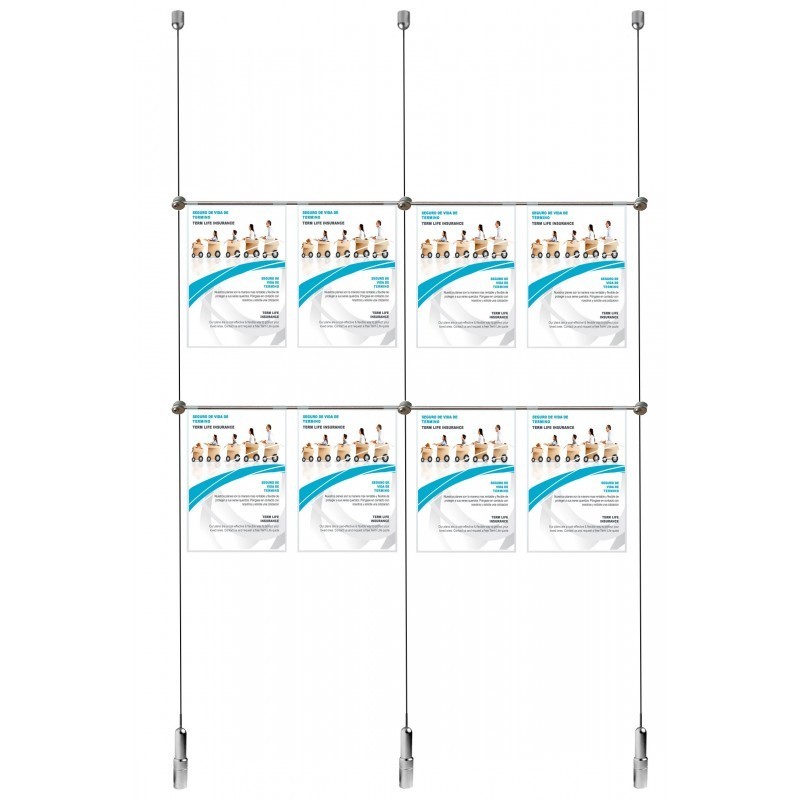This discreet and easy-to-use cable system is not just a display; it's a versatile tool to enhance merchandising,...
-
Picture Hanging
-
Wall Picture hanging
- Clip Rail Hanging System
- Heavy Duty J Rail Hanging System
- CLIP-RAIL SMART HEAVY DUTY
- Victorian Moulding
- J Rail Max Hanging System
- Clip Rail MAX Hanging System
- CLIP-RAIL PRO EXTRA HEAVY DUTY
- Mini Rail Hanging System
- Paper Rail Hanging System
- Plaster Rail system
- Deco Rail Picture Hanging System
- Picture Frame Security Fixings
- Picture Hanging System Kits
- Steel Chain Picture Hanging
- Rug & Coverlet Hanging kit
- Brass Rod Rail Hanging
- Sliding Picture Rails
- Magnet Hanging (Store Dispaly Supplies)
- Ceiling Systems
- Picture Rail Lighting System
- Sets: Art Gallery Systems
- Heavy Duty Picture Hanging & Mirror Hanging Kits
-
Wall Picture hanging
- Display Easels
- Cable & Rod Displays
-
Shelves
- Browsers & Sleeves
-
Others
Latest posts
-
 What is the best way to display posters? The Ultimate Retail Display Solution - A Guide for Store OwnersRead more
What is the best way to display posters? The Ultimate Retail Display Solution - A Guide for Store OwnersRead more -
 How to Use the Brass Cylinder Hook for Picture Hanging Wire System09/12/2025Read more
How to Use the Brass Cylinder Hook for Picture Hanging Wire System09/12/2025Read moreDetailed Guide: Using the Brass Cylinder Hook for Picture Hanging This guide will walk you through everything you...
-
 The Wooden Charpai: A Traditional Woven Bed of the Asian Subcontinent (Now Available in UK)06/10/2025Read more
The Wooden Charpai: A Traditional Woven Bed of the Asian Subcontinent (Now Available in UK)06/10/2025Read moreThe Charpai, also known as Charpaya or Charpoy (چارپائی), is a traditional woven bed that holds a significant place...
-
 How to Hang a Painting or Mirror on a Wall ? Using a Heavy Duty Mirror Hanging Kit06/03/2025Read more
How to Hang a Painting or Mirror on a Wall ? Using a Heavy Duty Mirror Hanging Kit06/03/2025Read moreHanging large artwork or mirrors can seem intimidating, but with the right hardware and method, it becomes a simple...
-
 Understanding Listed Buildings in the UK: Grades & Rules05/23/2025Read more
Understanding Listed Buildings in the UK: Grades & Rules05/23/2025Read moreListed buildings are an essential part of the United Kingdom’s cultural and architectural heritage. If you’re a...
-
 Why Professionals Choose Picture Hanging Systems Over Traditional Wall Hooks or Nails05/23/2025Read more
Why Professionals Choose Picture Hanging Systems Over Traditional Wall Hooks or Nails05/23/2025Read moreIn the world of art display, presentation matters just as much as the artwork itself. Whether you're curating a...
-
 Want to hang tapestry using picture hanging rail?03/26/2025Read more
Want to hang tapestry using picture hanging rail?03/26/2025Read moreTapestry is a form of textile art traditionally woven by hand on a loom. It involves creating intricate designs or...
-
 How to Use Your Foldable Wooden Easel (Tripod Studio Art Stand) - Buyer Guide12/17/2024Read more
How to Use Your Foldable Wooden Easel (Tripod Studio Art Stand) - Buyer Guide12/17/2024Read moreThe easel is made from solid beech wood, designed for durability and versatility. It's perfect for artists,...
-
 How to Hang a Transparent Acrylic Poster Holder Using a 3meter J Rail Display System12/09/2024Read more
How to Hang a Transparent Acrylic Poster Holder Using a 3meter J Rail Display System12/09/2024Read moreIf you want a clean, professional way to display posters, brochures, or samples, the 3m J Rail Display System with...
-
 Hanging Pictures Using Gallery Rails without the Need for Nails04/06/2024Read more
Hanging Pictures Using Gallery Rails without the Need for Nails04/06/2024Read moreUtilize high-quality gallery rails for sturdy support without the need for nails. Arrange artwork thoughtfully, using...
Blog categories
Search in blog
Want to hang tapestry using picture hanging rail?
Today, tapestries are still used in interior design, often as artistic wall decor. They can be handmade (as high-end art) or mass-produced for home decoration.
Hanging a tapestry on a wall can enhance your decor, but it comes with some challenges. Here are common issues and how to overcome them:
1. Choosing the Right Hanging Method
Problem: Tapestries can be heavy or delicate, requiring different hanging techniques.
Solutions:
Rod & Sleeve: If your tapestry has a sleeve, slide a curtain rod or wooden dowel through it and hang with brackets.
Velcro Strips: Sew or stick Velcro to the top edge and attach the other side to the wall for an invisible hold.
Clips & Hooks: Use decorative clips (like curtain rings) or brass hooks for lightweight tapestries.
Adhesive Hooks: Damage-free options like Command™ hooks work for small tapestries.
2. Preventing Sagging or Wrinkles
- Problem: Fabric can droop or bunch up over time.
- Solutions:
- Use a rod with finials to keep the tapestry taut.
- Secure the bottom with weights (e.g., small rods, hidden magnets, or discreet tacks).
- Iron or steam the tapestry before hanging to remove creases.
3. Avoiding Wall Damage
- Problem: Nails, screws, or adhesives can leave marks.
- Solutions:
- Use tension rods (for lightweight tapestries between two walls).
- Try museum putty or removable adhesive strips for small tapestries.
- For heavy tapestries, anchored screws in studs may be necessary.
4. Keeping It Straight & Aligned
- Problem: The tapestry shifts or hangs unevenly.
- Solutions:
- Use a level when installing rods or hooks.
- Double-check symmetry before finalizing placement.
- For large tapestries, secure multiple points along the top edge.
5. Protecting the Tapestry from Damage
- Problem: Sunlight, dust, or humidity can fade or degrade fabric.
- Solutions:
- Hang away from direct sunlight to prevent fading.
- Dust regularly with a soft brush or vacuum with a low-suction attachment.
- In humid areas, consider anti-mold treatments or occasional airing.
6. Hanging Without a Rod Pocket
- Problem: Some tapestries lack a sleeve for a rod.
- Solutions:
- Sew a sleeve (or use fabric glue) to create one.
- Use binder clips + a dowel as a makeshift hanger.
- Try clip-on curtain rings for an easy no-sew option.

Leave a comment